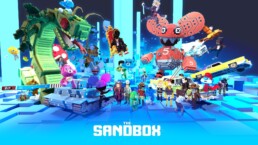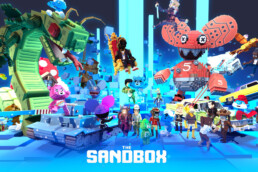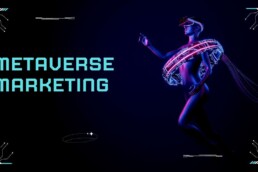Updated: May 6, 2023
The following is our guide for anyone looking to understand The Sandbox Metaverse. Our team have been building game experiences for it since late 2020 and have a detailed understanding of all the features, benefits and intricacies of the platform.
This guide will be continually updated as we get more information.
Table of Contents
1. What is The Sandbox Metaverse?
2. What are the different components of the ecosystem?
3. What is LAND?
4. How do you buy LAND?
5. What are voxel assets?
6. What is SAND?
7. What are gems?
8. What can you create?
9. What are Alpha Seasons?
10. How do you play in The Sandbox Metaverse?
11. How does The Sandbox compare to other metaverses?
12. What are the different ways I can invest?
What is The Sandbox Metaverse?
The Sandbox metaverse is a decentralized virtual world built on the Ethereum blockchain. It is part Minecraft and part Roblox.
It’s like Minecraft because it allows players to do creative block building. It’s like digital LEGOs in many ways. It’s also like Roblox because it allows players to create their own games and share it with others. Game experiences can be created without any knowledge of coding.
History Of The Sandbox Metaverse
The metaverse platform is the 3rd iteration of The Sandbox IP. It started out initially as a mobile game, launched back in 2012 by Pixowl.
The Sandbox had two very successful mobile games. They were both world builder games that allow other users to create 2D worlds and games. In essence, The Sandbox Metaverse is a 3D version of the previous two mobile games. Those two games have been downloaded an estimated 50M times.
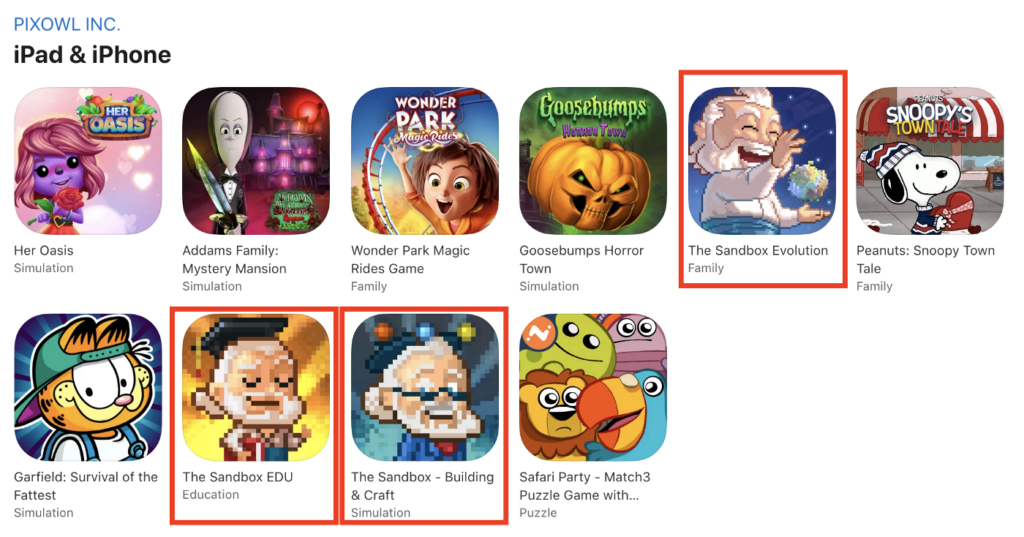 This current version of The Sandbox game, the blockchain version began back in early 2018. The partnership with Animoca Brands came in May that year when the company acquired Pixowl for $4.875 million.
This current version of The Sandbox game, the blockchain version began back in early 2018. The partnership with Animoca Brands came in May that year when the company acquired Pixowl for $4.875 million.
The two founders of The Sandbox are Arthur Madrid and Sebastien Borget. The Sandbox has raised a total of $95M to date, according to Crunchbase. The team has a long track record of delivering hit games, which is why we’re bullish on them.
What are the different software components of the ecosystem?
In our view, there are four major components of The Sandbox ecosystem. They are: VoxEdit, Game Maker, Marketplace and Game Client. Each is explained in detail below.
VoxEdit
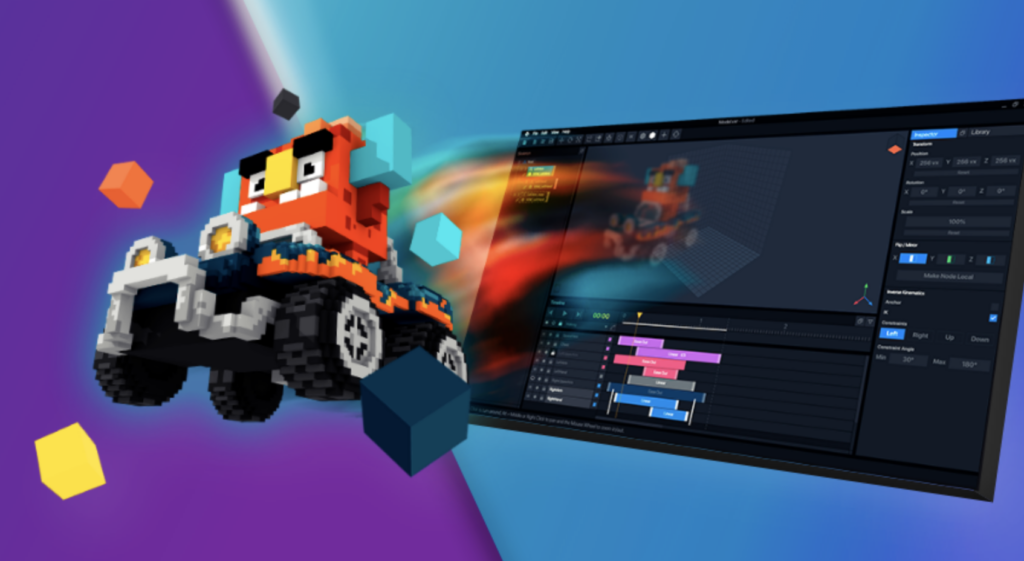
VoxEdit is the modeling software used by artists to create voxel assets for The Sandbox game. VoxEdit is similar to other voxel modeling software such as MagicaVoxel and Blockbench.
However, the major distinction is that the Sandbox assets have to be exported from the VoxEdit software. In other words, a voxel artist can create a voxel asset using MagicaVoxel, but in order for that asset to be usable in The Sandbox, they would need to import it into VoxEdit, and then exported to The Sandbox ecosystem through the software.
All the voxel avatars that we see are created using VoxEdit.
Game Maker
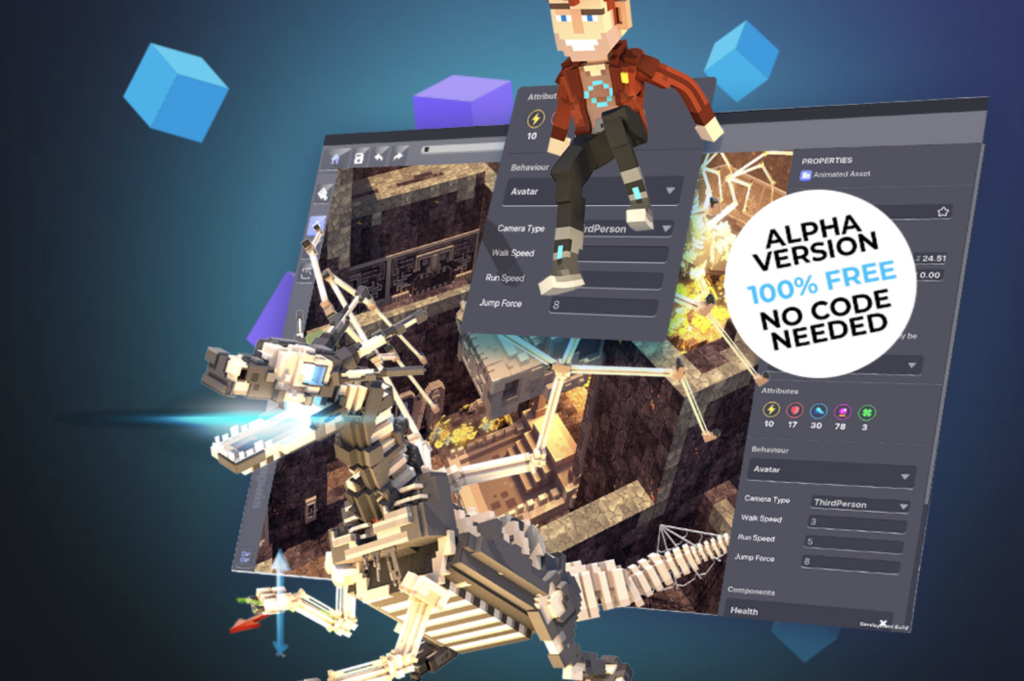
The Game Maker is the software used by creators to build game experiences. The Game Maker file contains the placement of the various voxel assets, the building blocks as well as the programming logic.
Creators can share their experience for others to play through the Gallery Tab. Sharing of experiences is off-chain.
Marketplace
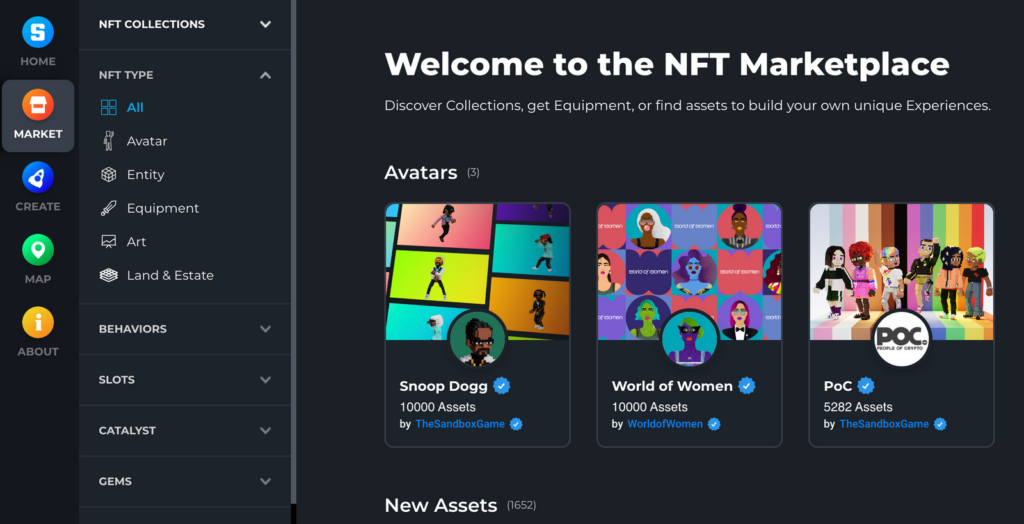
The Sandbox Marketplace is where players can buy and sell voxel assets, LAND and in the future full experiences. This would be considered the primary marketplace for anything related to The Sandbox. As such, everything in The Sandbox Marketplace is priced in SAND. With all these assets being NFTs, they can also be traded on secondary markets like OpenSea, Rarible, and Looksrare.
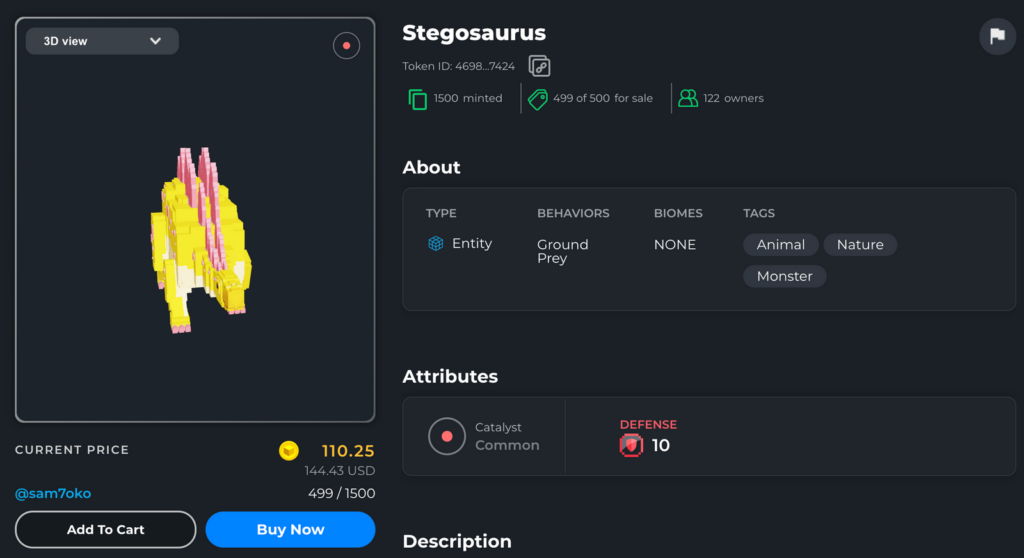 Example voxel asset in The Sandbox Marketplace
Example voxel asset in The Sandbox Marketplace
In the image above, notice that there’s a token ID associated with the asset. You can copy and paste that into OpenSea and see how the same asset is trading there.
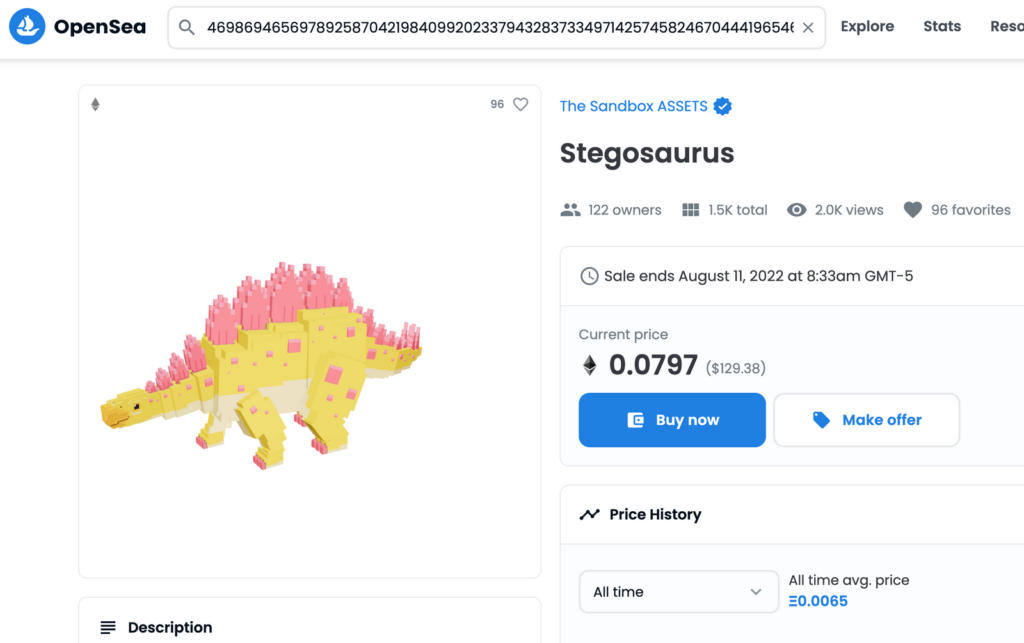 The same asset trading on OpenSea
The same asset trading on OpenSea
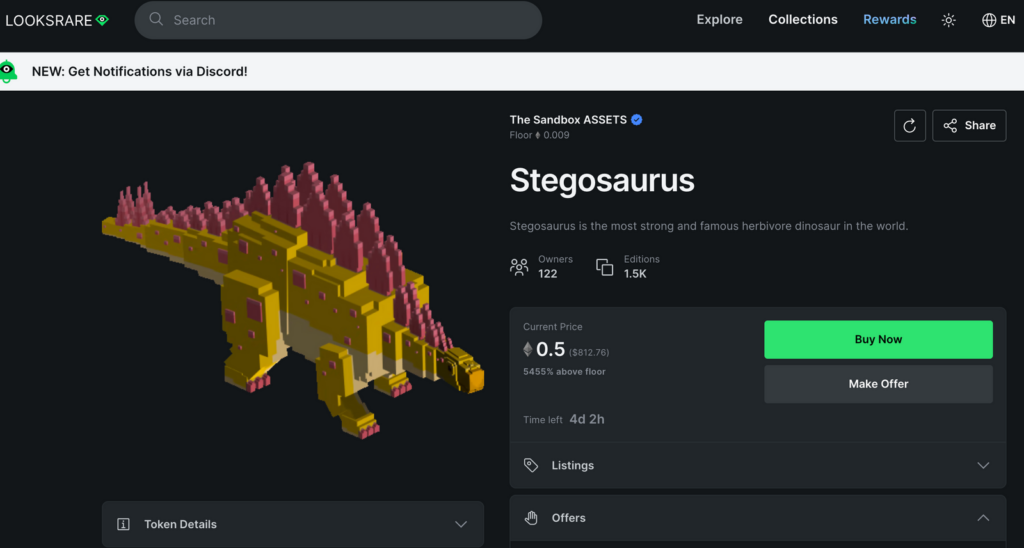 The same asset is also listed on Lookrare
The same asset is also listed on Lookrare
Game Client
The Game Client is not talked about much but still an important software in The Sandbox. Unlike the Game Maker software which is used primarily by creators, the Game Client is primarily used by players.
Roblox also has this dual software system. There is one that creators use to build games. And then there is one used by players.
The Game Client is a lightweight piece of software and loads much faster than the GameMaker software. Also, the GameClient only lets players access specific games as opposed to the Game Maker.
What is LAND?
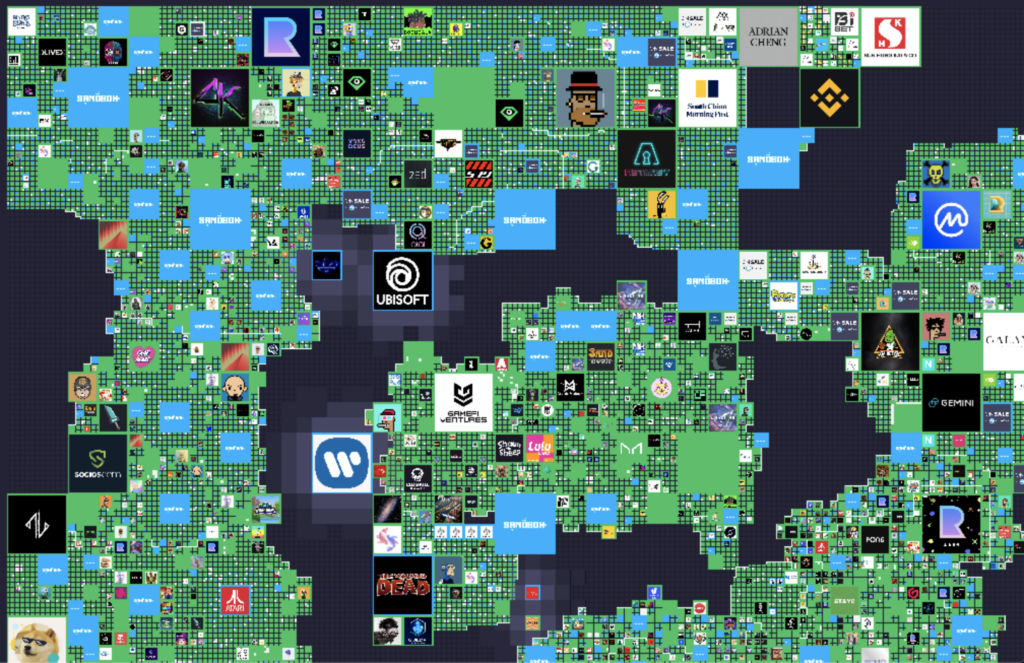 The Sandbox Map
The Sandbox Map
LAND is a limited resource in The Sandbox ecosystem that allows creators to build various experiences on it. It is a ERC-721 token. We’ll use two analogies to understand LAND better.
In Minecraft, anyone can start their own private server and create their own private world. These servers are usually created for multiplayer purposes. There is no limit to how many private servers can be created.
Now, imagine if Minecraft said there will only be 100,000 private servers ever in existence. In order to create your own world and monetize it, you have to buy one of these private server spots. That’s what LAND is.
Another way to think about LAND is comparing Sandbox to Roblox.
 Roblox Appstore Page
Roblox Appstore Page
For this comparison, I took a screenshot of the iOS appstore page for it. In the first screenshot, it says “Millions of worlds”. In Roblox, the equivalent of LAND would be worlds. When a creator designs their own game, they put the game logic and various game assets onto a “world” and then share it for everyone to play. In Roblox, there is no limit to the number of worlds. Again, imagine if Roblox said there would only be 100,000 worlds in existence ever. That’s what LAND is.
As stated on their website, there is a fixed amount of LAND: 166,464.
How big is the LAND?
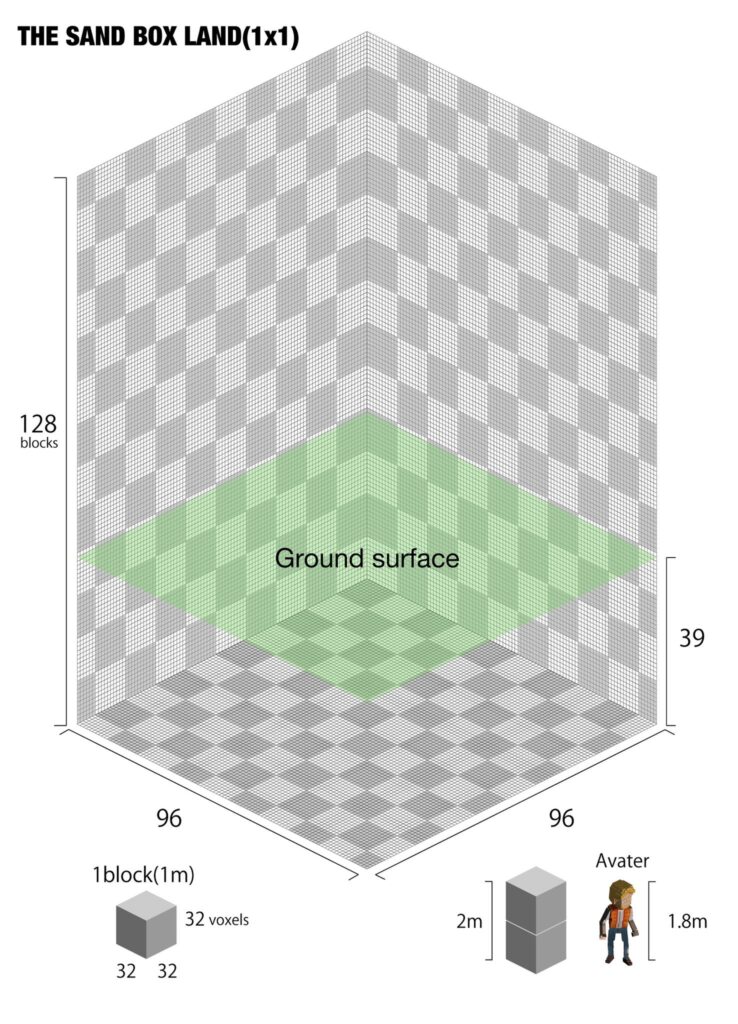 Each 1×1 parcel of LAND is 96×96 blocks. But it is also 128 blocks tall.
Each 1×1 parcel of LAND is 96×96 blocks. But it is also 128 blocks tall.
How do you buy LAND?
There are essentially three places to buy LAND: direct from the Sandbox team, secondary markets and through a 3rd party.
Direct LAND Sales
The Sandbox team periodically have LAND sales, sold in SAND tokens. Here is the link to their LAND sale schedule. The cost of a single 1×1 parcel of LAND have stayed the same when priced in SAND. We have heard the team say that it will always stay at that price. Buying LAND direct will always offer the lowest price.
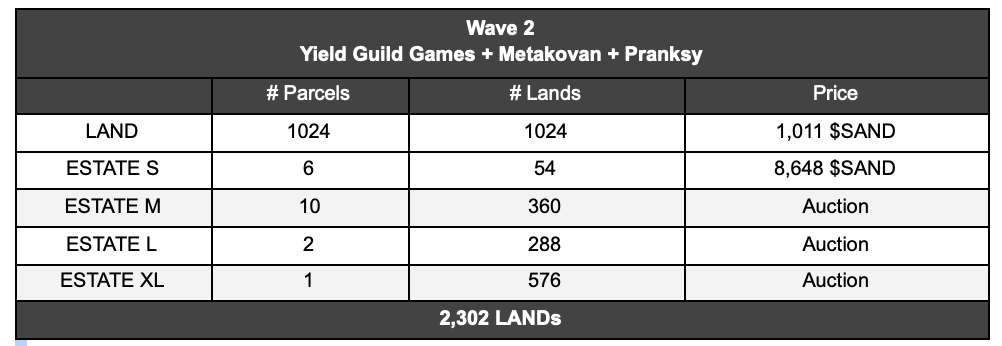 LAND prices in Wave 2, February 25th, 2021
LAND prices in Wave 2, February 25th, 2021
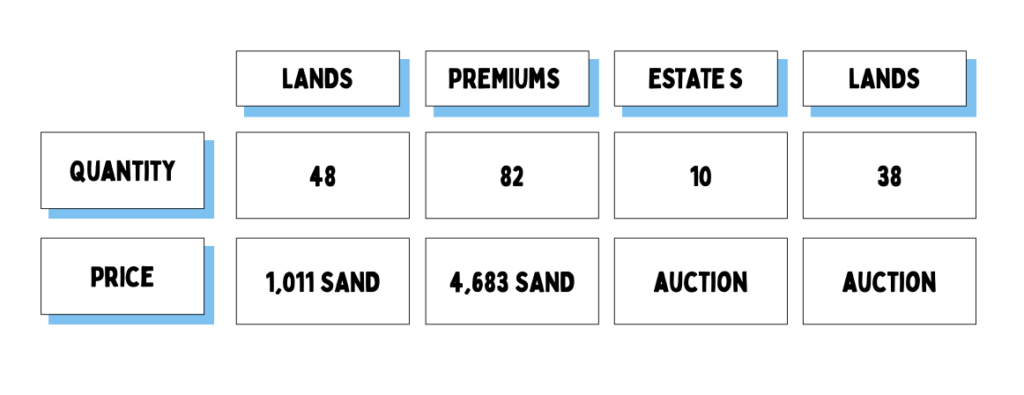 LAND prices for Mega City 2, April 28, 2022
LAND prices for Mega City 2, April 28, 2022
LAND Secondary Markets
LAND can also be purchased on OpenSea, Rarible or Looksrare. These are mostly priced in ETH, but some in SAND and USDC.
Buying LAND Through Third Parties
There have been a few third party brokers started to help buyers and sellers transact anonymously.
Can you rent LAND?
The team have said they will be building that functionality. Right now, renting of LAND is only offered by third party.
What are voxel assets?
Voxel assets are things a creator adds to a game experience. All the following things are assets: a tree, an animal, an elaborate door, a custom voxel avatar, etc.
In any Sandbox experience, there will be three things: blocks, assets, and game logic. The blocks are the foundational building blocks. The assets are used to both enhance a structure as well as to provide interactions for the game.
The game logic a player doesn’t see and is behind the scene. The game logic controls the interactions between the different voxel assets. When the player avatar talks to a NPC and receives a quest, that is created by game logic.
What is SAND?
SAND is the ERC-20 utility token of The Sandbox. Currently, the token is used in buying LAND directly from The Sandbox team, staking, and buying voxel assets from the marketplace. There are many more planned uses for the token, such as rewarding players in-game, and rewards for bounties. There is a finite supply of the SAND token: 3,000,000,000.
What are gems?
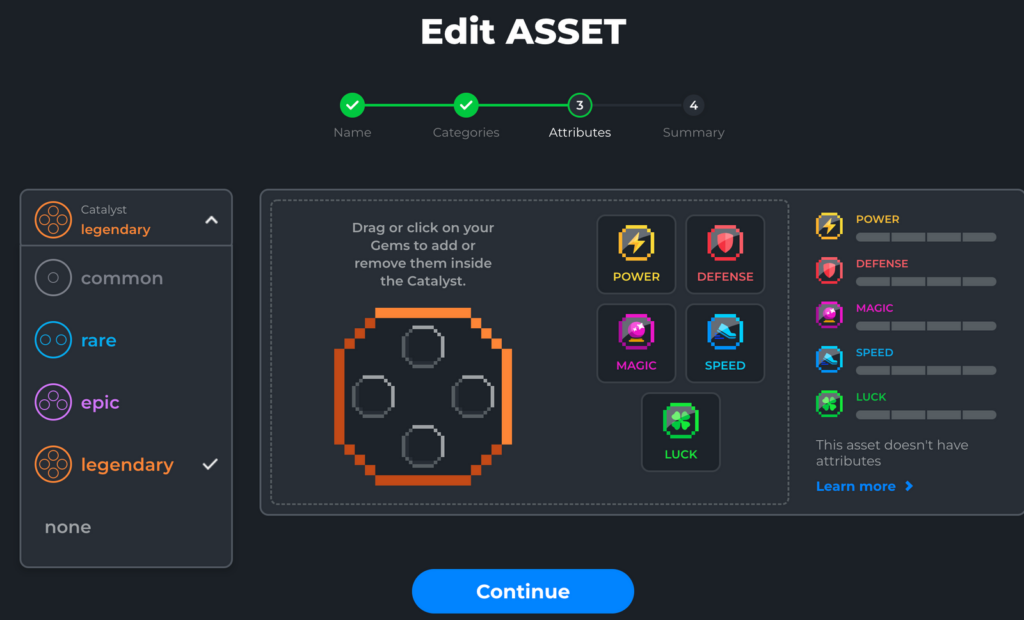
Gems are another part about The Sandbox ecosystem that is rarely talked about. They are used to create item rarity as well as to add stats to it. As a result, the ones who know about gems are usually the voxel artists. There are 5 different gems. and add to the corresponding stats: Power, Defense, Magic, Speed and Luck.
Let’s take a look at an example. In the image above, an item of legendary status requires four gems to be added. There are essentially 5 rarities, known as “Catalyst” in The Sandbox. Legendary items require four gems, epic items require three, rare items require two, and common items require one. But there’s also a fifth rarity in which an item can be created without using any gems. That’s denoted by “none” in the image above.
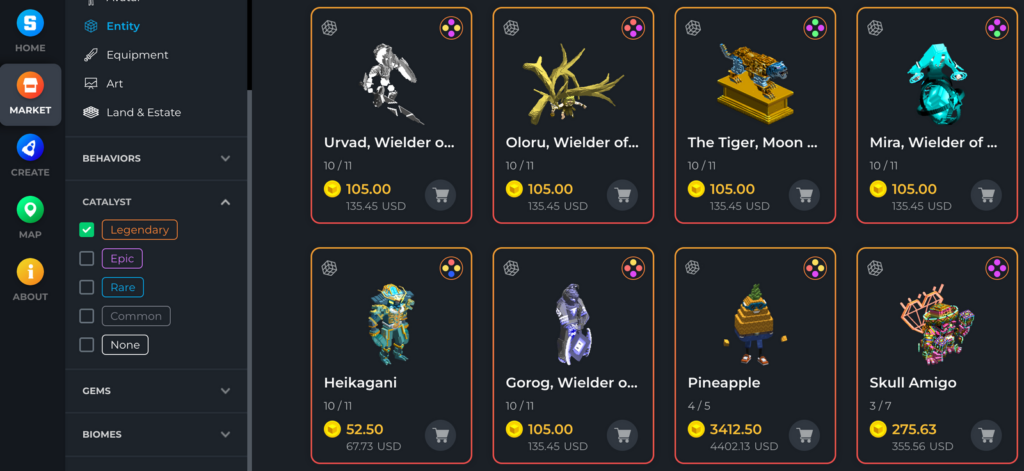
The item rarity also determines the number of copies of that item. For example, we see that the items in the above image only go up to 11 copies. They are all legendaries. However, I’ve seen some legendaries have as many as 200 copies. There seems to be an upper limit for each rarity but right now we’re unsure what that exact number is.
It’s unknown at this point how gems will be distributed.
What can you create?
We’ve seen a variety of experiences that people have created. Social hubs are a common thing creators build for NFT collections. As for games, we’ve seen everything from a Temple Run style runner to a Doom-like game. Here are 10 build ideas.
What are Alpha Seasons?
Alpha Seasons are 1-2 month long game showcases. In each Alpha Season, there are a large number of game experiences. In Alpha Season 3 for example, there was over 90 game experiences developed by big brands as well as small game studios. The Sandbox Metaverse is technically not live yet so the Alpha Seasons lets players experience the platform as if it was live.
There is also a huge reward incentive for players. In Alpha Season 3, The Sandbox rewarded the top players with 15M $SAND tokens. In order to qualify, players compete for the best cumulative completion time. Each game experience has a set of Ethnos points that players can earn by completing various quests. The top players on the leaderboard obtained all the Ethnos points available in the fastest amount of time possible.
The fastest time qualification usually requires a player to replay a game experience several times. At the time of this writing, The Sandbox recently finished its Alpha Season 3. The team have said that they plan to run Alpha Seasons until the game is live.
Alpha Seasons are only accessed through the Game Client, not Game Maker. All the experiences in Alpha Season are off-chain, another common misunderstanding. This confusion comes from the fact that players can click on an experience on the map, then be taken into the game through the Game Client. Even though this is the case, it is not minted to the Ethereum blockchain. It is simulated to show players what the real experience will be like.
What are Monthly Events?
Monthly events are similar to Alpha Seasons in that it is a games showcase, but the rewards are much smaller.
How do you play in The Sandbox Metaverse?
There are two ways to play game experiences in The Sandbox Metaverse. The first is through Alpha Seasons and Monthly Events. The second is through the Game Maker’s gallery tab.
As explained previously, Alpha Seasons are 1-2 month long game showcases while the Monthly Events are smaller showcases. In both cases, players access the games using the Game Client.
The other way to access game experiences is through the Game Maker software. Very often, developers share their in-progress game experiences with the community via the Gallery Tab in the Game Maker. For example, submissions to the game jams are shared using the Game Maker. Some of these games are very innovative and worth playing to get a sense of what’s possible with the platform.
Drafts Gallery
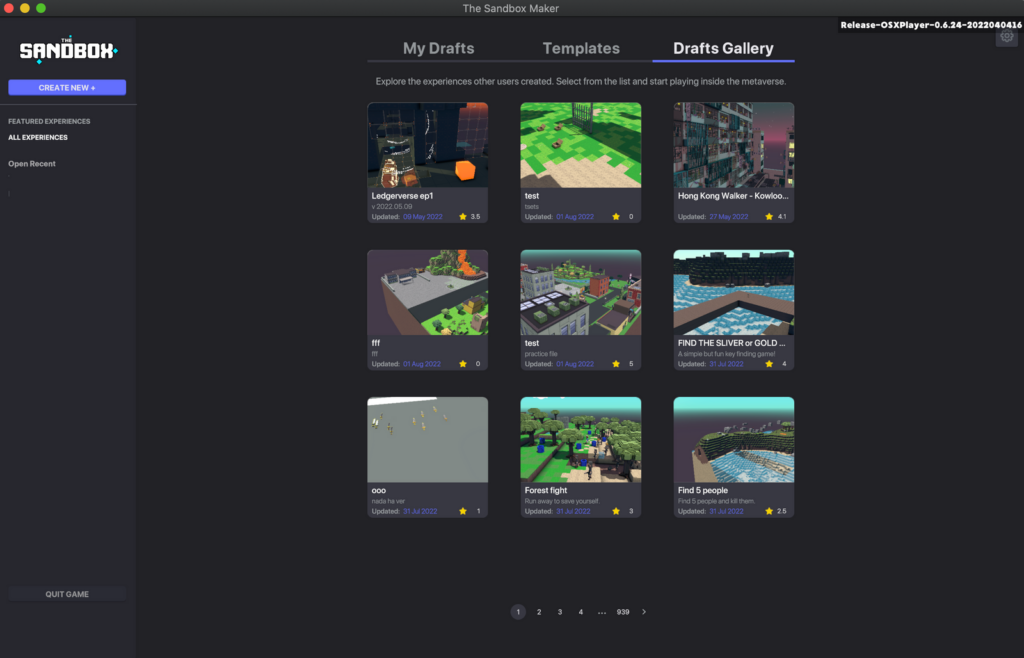
The Sandbox vs Other Metaverses
The Sandbox is often compared to these metaverses: Decentraland, Minecraft and Roblox. Let’s take a look at the similarities and differences of each.
The Sandbox vs Decentraland
The Sandbox is like Decentraland in that they’re both decentralized virtual worlds built on top of Ethereum. Both have a token, and have LAND. That’s pretty much where the similarities lie. There are a lot more differences, enabling completely difference usecases.
One of the main differences is that Decentraland is a single-instance, persistent world and The Sandbox is not. A player in Decentraland can walk from one end of the map to the other. That is not the case with The Sandbox metaverse. Because of this, creating games in Decentraland is significantly harder because the developers have to sync all the players nearby. Most of the games in Decentraland as a result are pretty simple.
The Sandbox on the other hand is an instanced-based world. Players can play a game that’s only single player or multiplayer. As a result, there is a wide variety of games that have been created. As The Sandbox team add more capabilities to Game Maker, we’ll seen an even greater variety.
The Sandbox vs Minecraft
The Sandbox gets compared a lot to Minecraft because of the voxel aesthetics. Minecraft is still the king for creative block building. There are still many players playing it just for that aspect, creating different epic structures. Minecraft on the other hand, doesn’t have a flexible game creation tool. Every game created is using the same default camera view.
In The Sandbox, you can see games that are top-down, side-scrollers, 1st person shooters, puzzles games and many more. Minecraft is also not decentralized and there are no NFTs.
The Sandbox vs Roblox
The Sandbox is very similar to Roblox in that all the games are user-generated. There is no default game mode like there is in Minecraft. The Roblox platform is as good as the games that are created on it. The same will be true of The Sandbox.
The biggest difference between The Sandbox and Roblox is that creating games on Roblox require coding.
What are the different ways someone can invest?
Disclaimer: None of this is financial advice of course, but here are some of the ways we’ve seen investors generate a ROI.
- Buy and sell the SAND token
- Buy LAND to flip or rent out
- Buy and sell the individual voxel assets
- Create experiences on LAND for others
- Create voxel assets to be sold on the marketplace
Buying and selling the SAND token is the most straight-forward way to invest in The Sandbox. The next way is buying LAND. Some longterm hodlers have purchase LAND and never sold. Others have flipped LAND on the secondary markets. And then another way that is emerging is renting out LAND.
We see some people buying and selling individual voxel assets on Opensea. It’s very similar to flipping LAND, but for individual game assets.
The fourth way someone can make money from The Sandbox is to create experiences for others. This is essentially what our team, Tentango does. Brands, NFT collections and some individuals have expressed a desire to be early adopters of The Sandbox and are looking for creators to build games, social hubs, and more on their LAND.
Then finally, an investor who’s also a creator might opt for this last option. They can create voxel assets to be sold in the Sandbox marketplace. Each of these are NFTs and thus have a creator royalty fee attached to it.
This wraps up our in-depth guide on The Sandbox Metaverse.
Get more insights like this on the business and marketing of the metaverse delivered to your inbox. We’ll never spam you, ever.
Jack Liu
Digital marketing entrepreneur with a background in engineering, paid advertising, and product development. Founder of Tentango.
Related Posts
June 14, 2023
How To Successfully Launch Games on Roblox, with Zach Letter of Wonder Works
How can developers successfully launch games on Roblox? In my recent…
May 20, 2023
Branding Success: Guaranteed Engagement in The Sandbox
The Sandbox Metaverse is a really interesting opportunity for branded…
March 7, 2023
Metaverse Marketing – The Emerging Practice
As the digital world continues to evolve, businesses need to stay ahead of the…
